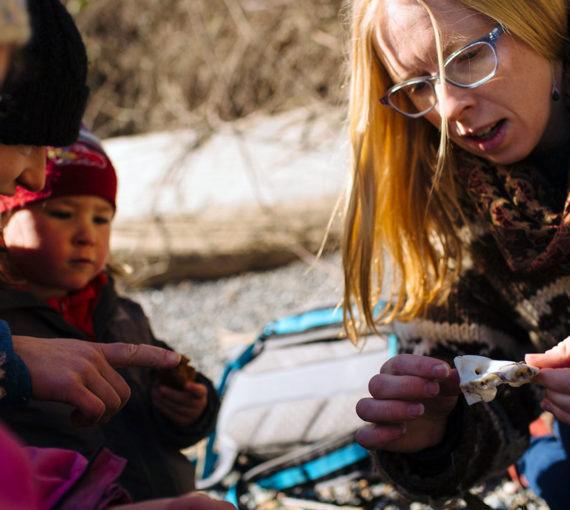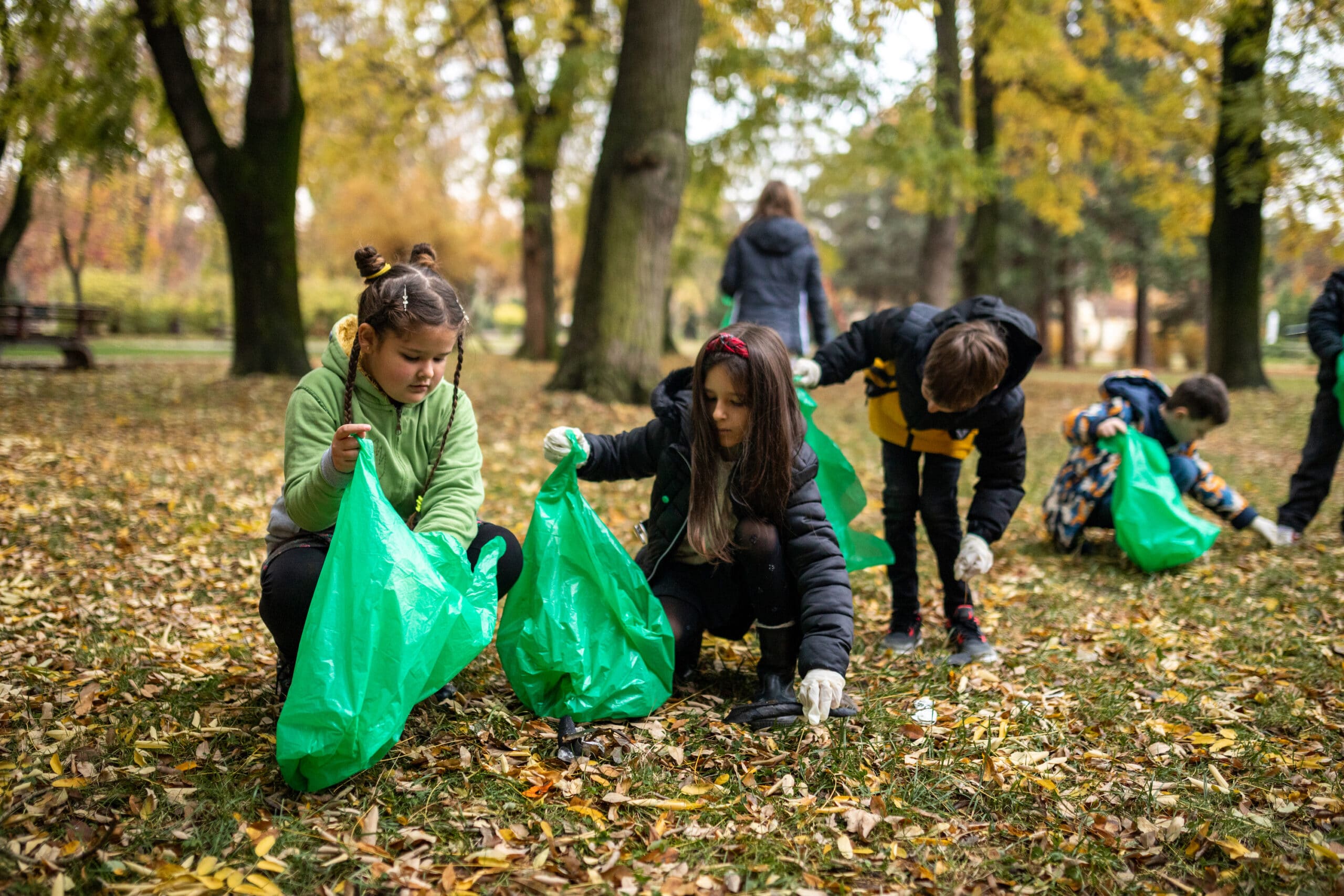
Host a school ground or community clean-up with your school green team.
Whether your classes are in person or virtual, at home or in a building, spark change and promote a culture of sustainability by starting a school green team. Students, parents, guardians, teachers and others can get involved and take initiative.
Solving the interconnected climate and biodiversity crises requires transformational change. Environmental concerns are at the forefront of global discourse. Places of learning can play a critical part in empowering current and future leaders. A green team can help the school community move toward sustainability while cultivating student autonomy, responsibility, leadership, eco-consciousness and much more!
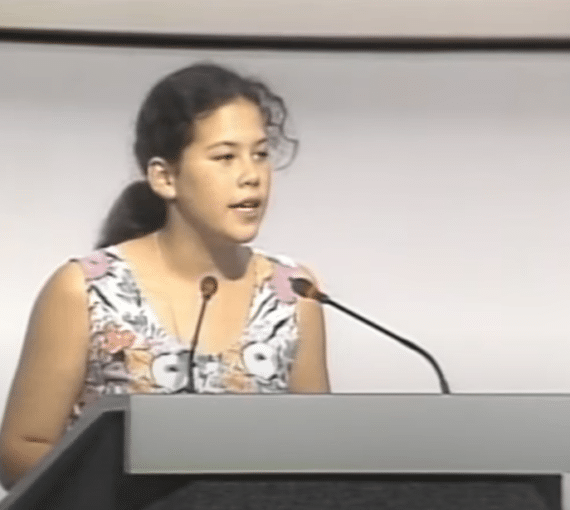
Did you know?
Our former executive director, Severn Cullis-Suzuki, organized her first environmental protest in kindergarten. She rounded up a crew of neighbourhood kids. They walked around the block with stuffies and signs saying “save-the-animals!”
Later, she and a group of friends started the Environmental Children’s Organization at school. That culminated in her famous speech at the 1992 Earth Summit in Rio de Janeiro when she was 12 years old.
Why start a school green team?
A green team addresses environmental concerns and makes a school and/or local community sustainable through advocacy and action. It can include students, staff and/or parents and guardians.
Create one at your elementary, middle or secondary school. You’ll see many economic, social and educational benefits.
Foster environmental awareness
A school green team provides opportunities to educate, raise awareness and engage with pressing environmental issues inside and outside the classroom. It can also motivate everyone involved to adopt green practices and take climate action outside school.
Create environmental stewards and advocates
Teaching kids to champion nature ignites their commitment to a lifetime of taking care of Earth. Your team’s campaigns will provide advocating, organizing and communications experience. It will help shape leaders, problem solvers and agents of change.
Inspire community engagement
A school green team brings people together to work toward common goals. It relies on collaboration, which helps create a sense community and shared responsibility.
Hands-on learning
By participating in school green team sustainability projects, students gain practical knowledge about environmental issues and develop skills in different ways to reduce their impact (e.g., native plant gardening, waste diversion, etc.).
Save money
Sustainable practices, such as reducing energy and water consumption, save money. Redirect those to other educational needs.
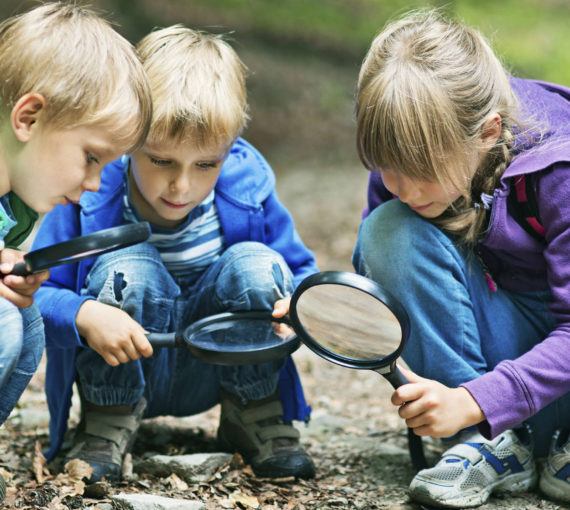
Connecting youth with nature
Kids need nature! And so do all the adults in their lives. Encourage kids to spend time outside. Teach them about environmental responsibility with these activity guides.
How to start a school green team
The first step is to get buy-in from staff, faculty and administration. This will give you permission to host an on-site or online student group. And it will ensure your green team realizes its goals and implements them schoolwide. You’ll need dedicated space (if in person) and scheduled time. Meet during lunch breaks or after school.
Starting a school green team requires dedication, collaboration and patience. If you need help getting your idea off the ground, apply for EcoSchool certification. You’ll get a framework and a toolbox.
As a student
If you’re a student, identify key advocates and supporters. Do you know teachers or other staff who share your passion for sustainability? Seek their advice and help in bringing your idea forward. Work together to build a proposal that outlines the school green team objectives, benefits and action plan. Emphasize how it will enhance the school community.
As a staff member
If you’re on staff, seek allies. Reach out to colleagues who share your interest in sustainability. Build a supportive faculty network. Collaborate on a proposal and present it to leadership.
Explore ways to incorporate sustainability topics into lessons. That way you can showcase the educational benefits of deploying a school green team while teaching related topics such as the importance of environmental stewardship. Take students outside for intentional time in nature.
As a parent or guardian
Caregivers can also play a pivotal role in kickstarting a school green team. Establish communications with administrators, teachers and other staff. Share your interest in starting a green team and inquire about their support. Form a small group to advocate for the green team’s creation. Ask school administrators to recruit interested student volunteers.
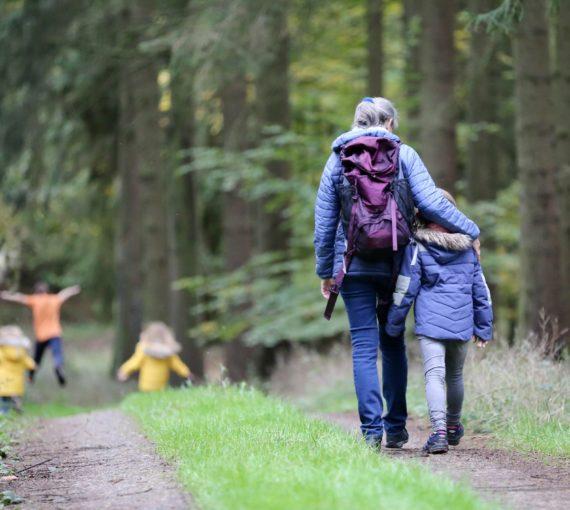
How to talk to kids about climate change
Climate change isn’t going away. That means adults need to find new and better ways to support young people by talking to them in age-appropriate ways.
Build your team
Aim for representation from different grades, faculty and staff from maintenance and operations. Encourage teachers from various subjects to take part. Seek out parents committed to the cause and willing to contribute their time, resources and/or expertise. Establish a meeting time and regular physical place or online time where everyone can meet for 30 to 60 minutes every week (or as often as possible). Ensure all students have signed permission slips allowing them to meet at the designated time and place each week.
Build positive team culture
A positive, supportive team culture will help your school green team work together. They’ll spend less time navigating conflicts and more on achieving their goals.
- Sit in a circle when meeting as an in-person group. Online, encourage people to turn their cameras on so people can see each other. This promotes fairness and allows students to focus on each other.
- Emphasize inclusivity and diversity. Make it clear that everyone’s opinions and contributions are valued, regardless of background, abilities or interests.
- Encourage open and honest communication. Emphasize sharing thoughts and ideas. Don’t allow judgement or ridicule. All this fosters trust.
- Lead by example. Model the behaviour and attitude you want to see in your students.
- Host regular check-ins with green team members to discuss experiences, challenges and ideas for improvement. Make sure people feel heard and valued.
- Create space for climate anxiety and grief. Caring about the climate crisis can be mentally draining and stir up anger, grief and anxiety. Host an climate support group. (Remember: action is the antidote to despair!) Focus on hope.
Building a positive school green team culture takes time and ongoing, consistent effort. Be patient and persistent. Reinforce values and behaviours that contribute to a healthy, supportive learning environment.
Define your vision
Imagine and discuss what sustainability might look like. Find out what other school green teams are doing for inspiration. Survey your team (or post an open survey to the whole school) to learn what issues or activities people are most passionate about. Write an environmental vision statement.
Assess your school’s needs
Encouraging sustainable practices at school is not easy. It requires participation from staff at all levels. Ask your school’s facilities team to help you request these audits and assessments:
- Request or host waste and recycling audits. These can reveal opportunities to reduce waste, increase recycling and start composting. If staff don’t have resources or time to conduct their own, host them. Get everyone involved.
- Request a water assessment. This will assess your school’s water use and potential leaks. It will identify opportunities for water efficiency improvements and promote water conservation practices.
- Request an energy audit. This will identify areas of high energy use and potential energy saving opportunities.
Choose your goals and develop an action plan
Use audit and survey results to brainstorm and set clear, achievable goals. Consider short- and long-term objectives that include fun, engaging activities.
Tip! Check your municipal government and/or local school board websites for environmental education program guides and information.
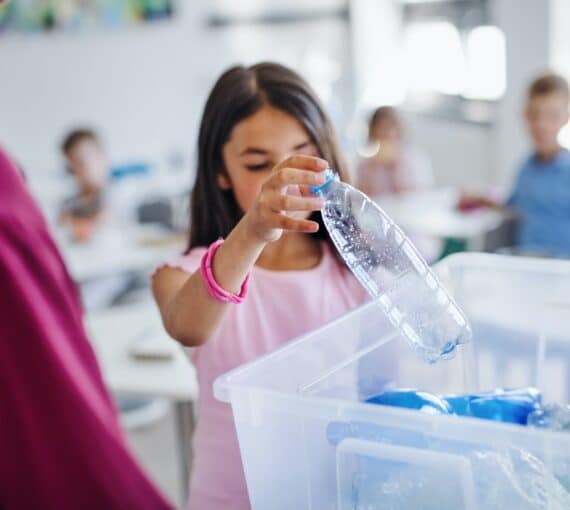
Examples of school green team goals:
- Start a compost program, including on-site bins.
- Minimize food waste.
- Promote better recycling and waste habits.
- Host eco-friendly events.
- Advocate for renewable energy projects on campus.
- Promote active transportation to and from school.
- Host eco-awareness campaigns.
- Collaborate with local environmental organizations.
- Hold quarterly educational workshops (e.g., climate media literacy, how to spot greenwashing, climate change basics, etc.).
- Donate and/or recycle unused classroom supplies and electronics.
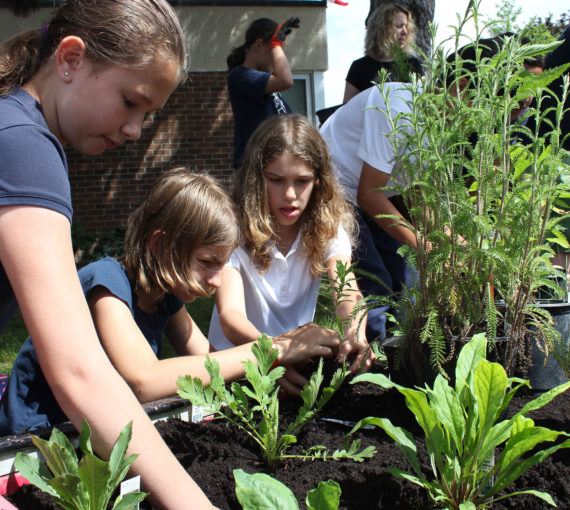
Possible school green team activities:
Create spaces that build awareness around green team goals to strengthen your team and build momentum.
- School ground or community clean-up. Litter releases pollutants into the air, water and soil.
- Zero-waste classroom. Demonstrate the principles of waste reduction and material consumption.
- Native plant garden. Native plants attract pollinators and help capture and recycle rainwater run-off. Transform existing unused green space or ask for garden space to plant. Host hands-on workshops that teach the importance of native plants and pollinators. Help grow young farmers.
- Rain barrels. Catch rainwater that can be used for your school garden. Encourage fun creativity by running a rain barrel painting party.
- Commuter challenge. Inspire active transportation and promote urban sustainability. Host a wrap party to celebrate challenge stories and success. (Maybe organize a bike bus.)
- Supplies drive. At the beginning or end of an academic term or year, help students with excess, unused supplies such as notepads, pens, binders and backpacks give them to other students or donate them to the community.
- Recycling centre or landfill visit. Expose students to waste diversion efforts and programs.
- Climate rally. Young people are at the forefront of climate action and more school boards are supporting student participation during school hours. Your green team can lead on this for your school. Host sign-making workshops, provide rally safety information and determine a meeting space on the day of the event.
- Craft. Use “waste” and/or recyclables to create a mural for your classroom. Host an art competition using stuff found in your schoolyard or from a community clean-up.
Remember: Do what you can, with what you have. Don’t burn yourself and the group out by setting overly ambitious goals too quickly. Start small and work your way up.
How to advocate for change when met with resistance
Advocacy aims to influence policies in social, political, economic and cultural spaces to elevate justice and positive change. Student advocates inspire change by taking “what is” and transforming it into “what should be.” A school green team is a perfect place for this work — a collaborative setting that can help ensure implemented changes last. But it’s common for advocacy to be met with some resistance.
To help tailor your approach, first try to understand the sources of obstacles. Are they coming from specific individuals, lack of knowledge, budget constraints, concerns about impacts of change?
- Connect over shared values. Climate change conversations can be challenging. Start by naming shared values. Advocate for the “why” that inspired your school green team. Our CliMate chatbot can help!
- Provide data and evidence that supports your goals, projects and ideas. Show how similar initiatives have been successful elsewhere. Provide concrete examples of the positive impact sustainability practices will have on the school community.
- Invite collaboration. Involve resistant parties in the decision-making process. Seek their input in shaping initiatives. Help them feel more invested in the mission.
- Leverage external resources. Seek support and guidance from sustainability organizations, experts and community partners. They can provide valuable insights and resources to overcome specific challenges.
- Address budget concerns. If these are primary problems, explore funding opportunities through grants, sponsorships or cost-sharing with other departments. Or try fundraising — use these tips to get started.
Addressing obstacles and resistance is a natural part of advocating for change. By taking a strategic, patient approach and building a network of support, you can overcome these challenges and drive your school green team initiatives and goals forward.
According to a David Suzuki Foundation survey, people who spend time outside when they’re young are 20 per cent more likely to take part in outdoor programs or to explore nature on their own when they’re older. And getting kids into nature will provide some of their best childhood memories.

Your green back-to-school guide
As parents, teachers and students of all ages shop for clothing, electronics, food and supplies, frenzied consumerism can run up costly bills and lead to unnecessary waste.
Make it fun and celebrate progress
School is a place for learning, growing and having fun. Ensure activities you plan and host to support your school green team’s aims are engaging, collaborative and encourage play and joy. Gamify your goals. Incentivize participation in challenges. Be creative.
Document your green team journey and share your success stories within your school and with other schools and communities. Prepare a monthly bulletin or newsletter. Write to your local newspaper. Your experiences and lessons can inspire others to take similar steps toward school sustainability.

